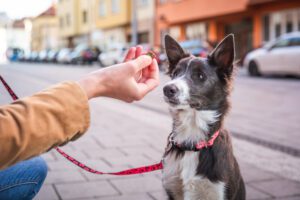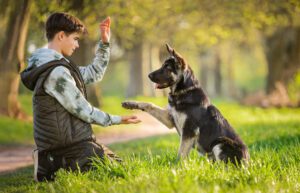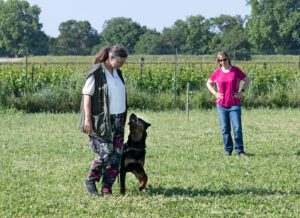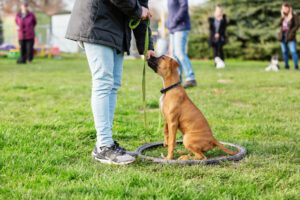Has this ever happened to you? You are out and about with your puppy and you give them a command that they should know by heart and your puppy simply… does not do it. “But they do it perfectly at home!” you may think. Has your puppy forgotten all of their training? Do they just not listen to you anymore? Don’t worry! You aren’t starting from square one and your puppy is (probably) not ignoring you on purpose. What you’re facing is an issue of generalization.
A Quick Overiew

- Dogs do not instinctively understand that a command is universal
- Small changes in context, such as a different location, different people present, or even a small shift in body language from their handler can confuse a dog that has not learned to generalize a command
- To counteract this, master a command in a single environment, then begin practicing from scratch in a new environment
- Keep sessions short (>15 minutes) and positive
- The more places you practice, more your puppy will understand the command applies anywhere and everywhere!
A Deeper Dive
What is Generalization?
In the context of dog behavior, generalization is your dog’s ability to react to a cue with the same behavior or emotion. A dog that performs the same trick, regardless of their environment or any distractions, is generalizing. A dog that has a bad experience with the vet and develops a fear of anyone wearing a white coat is also generalizing. Broadly speaking, generalization for dogs can be broken down like this:
Dogs are bad at generalizing commands, and good at generalizing emotions.

For the purposes of this article, we will be focusing on generalizing commands.
Obedience and Generalization
Humans and dogs tend to approach obedience differently. When a human teaches a dog a command like “sit”, the expectation is that this dog will know the command forevermore and be able to perform it anywhere and at any time. A dog, on the other hand, has learned that when in this particular environment and under these particular circumstances, the word “sit” means to sit down.
To bridge this gap of expectations, it is up to the human trainer to teach the dog that “sit” has the same meaning regardless of context. Here’s how to do it.
Teaching Your Dog Generalization
Be Consistent
Consistency for Humans

If the objective is to train your dog that the same command always has the same meaning, you must be certain that you are always giving the same command. Verbal or physical cues should be kept consistent. Do not interchange “down” with “lie down”. Similarly, if you have taught them that “down” means lie down, do not use it to order your puppy off the couch. If you include a physical cue, such as pointing to where you want them to lie, anticipate that you will have to do this every time you give the command. If you have multiple members in your household that will be training your puppy, decide on consistent cues together.
Consistency for Your Dog
You should also understand what it is that you are expecting your puppy to do when you give them a command. When your puppy sits, is it enough to sit down for a second, or do they have to wait for a release command? Your dog is not a mind reader. If you have taught them that either version is acceptable, you cannot expect them to know which you anticipate in that moment. How stringent you want to be is up to each owner. Just be sure that the behavior you’re training is the one you truly want to see!
Train Your Puppy in Different Environments
To help your puppy generalize, your puppy will need to be trained in different environments. At first, this can be as simple as giving a command in different rooms in your house. If you have a back yard, practice with your puppy outside. Then you can move on to the wider world – and there are a bunch of potential training spots! Practice at the park, in dog friendly-stores, or when you’re visiting a friend’s house, or when someone is visiting your house. Practice at different times of day, with different people and animals around.
Have a Reward on Hand

Whether it’s treats, toys, or a simple scratch behind the ears, your puppy’s hard work should be rewarded. If they are expected to perform behaviors and receive no reinforcement, they do not know when they have performed correctly. Having a behavioral marker tells your dog that they have done a good job. Moreover, if training goes consistently unrewarded, your dog may decide that it is not worth the effort. Remember also that the more interesting the environment, the more interesting you will have to be to maintain your puppy’s attention. High value rewards are what will keep them focused on you rather than distractions.
Start Small, Then Ramp Up
When teaching an entirely new behavior, it is always best to start in an environment with minimal distractions. Your puppy should also be well-rested and, if possible, have burned off their excess energy. Once your puppy can consistently perform a behavior, you are ready to move onto a different level of difficulty. Factors that affect how difficult a behavior is to perform includes things such as:
- How many distractions are in the vicinity
- How far away your puppy is from you
- How long they are expected to maintain the behavior
- How quickly they are expected to comply with the command
- How precisely they must follow the command (see our earlier example under the shaping behavior sectionBalance the difficulty. This trainer is sacrificing distance to work on precision (sitting in a hoop)

As you move to novel environments, you may need to scale back the difficulty of the behavior at first. As your puppy is able to perform the behavior consistently, you can raise expectations until they are able to perform as well as they can in familiar environments.
Resist the Urge to Repeat Yourself!
If you give your puppy a familiar command and they do not comply, you may be tempted to repeat the command. Dogs have exceptional hearing; unless it is extremely loud, your dog almost certainly heard you. By repeating the command over and over again, what you are inadvertently teaching them is that the command does not require a response from them. That is the opposite of what we want!
If you want to try the command again, wait a few seconds. Do not pet or praise the dog during this time, and certainly do not give them any treats or toys. Move to a slightly different spot, then try again. If your puppy is consistently struggling, consider dialing down the difficulty by moving to a less distracting spot, moving closer, or even luring them in the behavior to remind them what you want them to do.
Finally, bear in mind that training is a lot of work! If your puppy seems worn out, or you feel yourself becoming frustrated, it is time to wrap up for the day. Try to end things on a positive note, and remember – this is not defeat! This is an opportunity to try again another day.
Look for Training Opportunities
As you and your puppy are out and about, keep your eyes peeled for potential training opportunities. You never know when a novel situation can crop up. To paraphrase Dr. Seuss, they should do it in the rain, they should do it on a train… Carrying dog food, treats, or a toy with you makes any spontaneous moment an opportunity for learning.
Practice Makes Perfect!

The more environments you practice a behavior in, the more your puppy will realize it is the command, not the circumstances, that requires the response. The more your puppy understands this, the more quickly they will pick it up in new environments. Finally, there will come a day when your puppy responds to the command instantly in any environment. Congratulations! They have generalized this behavior. Do still practice from time to time to make sure that they don’t get rusty. However, you can celebrate the fact that you and your puppy have truly mastered this trick!



